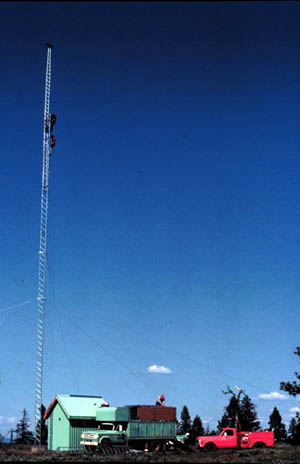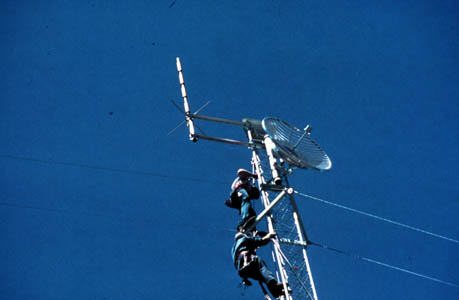 Loran tower – Starkey Loran research photos 2001
Loran tower – Starkey Loran research photos 2001To say that enhanced Loran (eLoran) has been an on-again off-again program would give short shrift to multiple generations of official ambivalence about the proposed backup for GPS.
The latest chapter began on June 4 when Senator Maria Cantwell (D-Washington) introduced S. 1194, the Coast Guard Authorization Act for Fiscal Years 2010 and 2011 (FY2010/11).
Among other details, the measure directs the Secretary of Transportation to continue the Loran system until a plan has been drawn up and implemented to transition the program to eLoran.
To say that enhanced Loran (eLoran) has been an on-again off-again program would give short shrift to multiple generations of official ambivalence about the proposed backup for GPS.
The latest chapter began on June 4 when Senator Maria Cantwell (D-Washington) introduced S. 1194, the Coast Guard Authorization Act for Fiscal Years 2010 and 2011 (FY2010/11).
Among other details, the measure directs the Secretary of Transportation to continue the Loran system until a plan has been drawn up and implemented to transition the program to eLoran.
In effect, this would reverse the course set by President Obama, whose FY10 budget proposal calls for termination of Loran in the coming year. At a May 7 press conference the president described Loran as a system that’s been eclipsed by the rise of GPS.
“Year after year, this obsolete technology has continued to be funded even though it serves no government function and very few people are left who still actually use it,” Obama said.
The president’s proposal had overruled plans set in motion last year for the Department of Homeland Security (DHS) to complete the upgrade to eLoran as a backup to GPS.
Now, S. 1194 would authorize the appropriation of $37 million for each of fiscal years 2010 and 2011 and direct the U.S. Coast Guard (USCG) to modernize and upgrade the Loran infrastructure to provide eLoran services. Under the legislation, the Department of Transportation (DoT) could transfer funds from the Federal Aviation Administration (FAA) or other DoT agencies to reimburse the USCG for costs of the modernization.
The activity comes at the same time that a Government Accountability Office (GAO) report warns about the possibility that the GPS constellation may decline substantially in the coming years.
Prospects for passage of S. 1194 appear promising. Cantwell is chairwoman of the Oceans, Atmosphere, Fisheries, and Coast Guard subcommittee of the Senate Committee on Commerce, Science, and Transportation to which S. 1194 has been referred.
Three senators join her as cosponsors of the measure: Sen. Olympia Snowe (R-Maine), the ranking Republican member of the subcommittee; John D. Rockefeller IV (D-West Virginia), chairman of the Commerce, Science, and Transportation Committee itself, and Kay Hutchison (R-Texas), the committee’s ranking Republican.
The legislation implicitly confirms the findings of an Independent Assessment Team (IAT) on eLoran, funded by the office of the under secretary of transportation policy and chaired by Brad Parkinson, the first program manager for GPS.
DoT contracted with the Institute for Defense Analysis (IDA), which organized the IAT with IDA staff member Jim Doherty serving as the IAT’s executive director.
If offset by an estimated $146 million decommissioning cost of existing Loran infrastructure, the IAT concluded that eLoran could be established effectively for free.
Going forward, eLoran would require only the current $37 million per year in USCG operations and management base funds for Loran plus $20 million a year in new funds for five to eight years to complete all upgrades, new transmitters, and “jump start” deferred maintenance.
After that time, savings from substantially reduced staffing at the modernized facilities would offset eLoran operational and sustainment costs.
In December 2006 the IAT unanimously recommended that for, at least the next 20 years, eLoran “be completed and retained as the national backup system for critical safety of life, national and economic security, and quality of life applications currently reliant on position, time, and/or frequency from GPS.”
Among the IAT’s key findings: “eLoran is the only cost-effective backup for national needs; it is completely interoperable with and independent of GPS, with different propagation and failure mechanisms, plus significantly superior robustness to radio frequency interference and jamming.”
Despite the report’s acceptance by the Bush administration, which relied on it for the DHS decision to move forward with eLoran, a summary of the IAT findings and supporting charts was only released in May. Parkinson told Inside GNSS that he estimates the probability of Congress approving eLoran at 75 to 80 percent.
Currently, the Radio Technical Commission for Maritime Services (RTCM) is developing performance standards for eLoran in the maritime environment. eLoran also has strong support from the General Lighthouse Authorities (GLA) of the UK and Ireland (equivalent to USCG for navigation services), which have committed to e-Navigation for maritime safety, using GPS/DGPS as primary input, eLoran as secondary or backup, and electronic charting.





